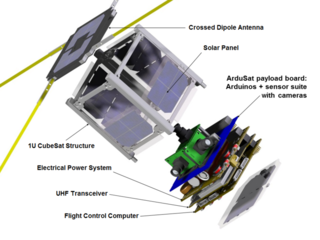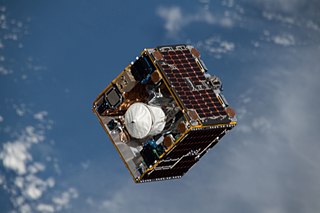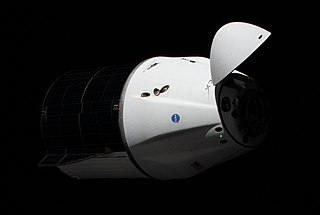
A CubeSat is a class of miniaturized satellite based around a form factor consisting of 10 cm (3.9 in) cubes. CubeSats have a mass of no more than 2 kg (4.4 lb) per unit, and often use commercial off-the-shelf (COTS) components for their electronics and structure. CubeSats are put into orbit by deployers on the International Space Station, or launched as secondary payloads on a launch vehicle. As of August 2021, more than 1,600 CubeSats have been launched.
Technology Education Satellite (TechEdSat) is a successful nano-sat flight series conducted from the NASA Ames Research Center in collaboration with numerous universities. While one of the principal aims has been to introduce young professionals and university students to the practical realm of developing space flight hardware, considerable innovations have been introduced. In addition, this evolving flight platform has tested concepts for Low Earth Orbit (LEO) sample return, as well as planetary nano-sat class mission concepts.

ArduSat is an Arduino based nanosatellite, based on the CubeSat standard. It contains a set of Arduino boards and sensors. The general public will be allowed to use these Arduinos and sensors for their own creative purposes while they are in space.

Nanoracks LLC is a private in-space services companywhich builds space hardware and in-space repurposing tools.The company also facilitates experiments and launches of CubeSats to Low Earth Orbit.

The Nanoracks CubeSat Deployer (NRCSD) is a device to deploy CubeSats into orbit from the International Space Station (ISS).

CubeSat for Solar Particles (CuSP) is a low-cost 6U CubeSat to orbit the Sun to study the dynamic particles and magnetic fields. The principal investigator for CuSP is Mihir Desai, at the Southwest Research Institute (SwRI) in San Antonio, Texas. It was launched on the maiden flight of the Space Launch System (SLS), as a secondary payload of the Artemis 1 mission on 16 November 2022.

The Miniature X-ray Solar Spectrometer (MinXSS) CubeSat was the first launched National Aeronautics and Space Administration Science Mission Directorate CubeSat with a science mission. It was designed, built, and operated primarily by students at the University of Colorado Boulder with professional mentorship and involvement from professors, scientists, and engineers in the Aerospace Engineering Sciences department and the Laboratory for Atmospheric and Space Physics, as well as Southwest Research Institute, NASA Goddard Space Flight Center, and the National Center for Atmospheric Research's High Altitude Observatory. The mission principal investigator is Dr. Thomas N. Woods and co-investigators are Dr. Amir Caspi, Dr. Phil Chamberlin, Dr. Andrew Jones, Rick Kohnert, Professor Xinlin Li, Professor Scott Palo, and Dr. Stanley Solomon. The student lead was Dr. James Paul Mason, who has since become a Co-I for the second flight model of MinXSS.

The Nanoracks Bishop Airlock is a commercially-funded airlock module launched to the International Space Station on SpaceX CRS-21 on 6 December 2020. It was berthed to the Tranquility module on 19 December 2020 by the Canadarm2. The module was built by Nanoracks, Thales Alenia Space, and Boeing. It is used to deploy CubeSats, small satellites, and other external payloads for NASA, Center for the Advancement of Science in Space (CASIS), and other commercial and governmental customers. NASA plans on using the airlock as a brand new way to dispose large pieces of trash. The name refers to the bishop chess piece, which moves diagonally.

InflateSail was a 3U CubeSat launched on PSLV C38 on 23 June 2017 into a 505 km polar Sun-synchronous orbit. It carried a 1 m long inflatable rigidizable mast, and a 10 m2 drag-deorbiting sail. Its primary aim was to demonstrate the effectiveness of drag based deorbiting from low Earth orbit (LEO). Built by Surrey Space Centre of the University of Surrey, it was one of the Technology Demonstrator CubeSats for the QB50 mission. An identical drag sail payload was planned to be included on the RemoveDEBRIS demonstrator.

RemoveDEBRIS was a satellite research project intending to demonstrate various space debris removal technologies. The mission was led by the Surrey Space Centre from the University of Surrey with the satellite's platform manufactured by Surrey Satellite Technology Ltd (SSTL). Partners on the project included Airbus, ArianeGroup, Swiss Center for Electronics and Microtechnology, Inria, Innovative Solutions In Space, Surrey Space Centre, and Stellenbosch University.
The ISS U.S. National Lab, commonly known as the ISS National Lab, is a U.S. government-funded national laboratory established on 30 December 2005 by the 2005 NASA Authorization Act. With principal research facilities located in the United States Orbital Segment (USOS) of the International Space Station (ISS), the Laboratory conducts research in life sciences, physical sciences, technology development and remote sensing for a broad range of academic, government and commercial users. Of the 270 payloads that the Center for the Advancement of Science in Space (CASIS) has sent to the ISS, 176 have been for commercial companies including Merck & Co., Novartis, Eli Lilly and Company, Hewlett Packard Enterprise, Honeywell, and Procter & Gamble.

IceCube, also known as Earth-1, was a 3U CubeSat satellite funded and developed by NASA. Its goal was to demonstrate and map ice clouds through the use of its 883 GHz radiometer.

SpaceX CRS-22, also known as SpX-22, was a Commercial Resupply Services (CRS) mission to the International Space Station (ISS) that launched at 17:29:15 UTC on 3 June 2021. The mission is contracted by NASA and is flown by SpaceX using a Cargo Dragon 2. This is the second flight for SpaceX under NASA's CRS Phase 2 contract awarded in January 2016.

NG-15, previously known as OA-15, was the fifteenth launch of the Northrop Grumman robotic resupply spacecraft Cygnus and its fourteenth flight to the International Space Station (ISS) under the Commercial Resupply Services (CRS) contract with NASA. The mission launched on 20 February 2021 at 17:36:50 UTC. This is the fourth launch of Cygnus under the CRS-2 contract.

SpaceX CRS-24, also known as SpX-24, was a Commercial Resupply Service mission to the International Space Station launched on 21 December 2021, at 10:07:08 UTC. The mission is contracted by NASA and is flown by SpaceX using a Cargo Dragon. This is the fourth flight for SpaceX under NASA's CRS Phase 2 contract awarded in January 2016.

SpaceX CRS-26, also known as SpX-26, is a Commercial Resupply Service mission to the International Space Station (ISS) launched on 26 November 2022. The mission is contracted by NASA and is flown by SpaceX using a Cargo Dragon. This is the sixth flight for SpaceX under NASA's CRS Phase 2 contract awarded in January 2016.

Cosmic X-ray Background Nanosatellite-2 was a satellite and mission developed by the Morehead State University to follow up on the CXBN mission launched in 2012. It was an improved version of the previous spacecraft and it increased the precision of measurements of the cosmic X-ray background in the 30-50 keV range and helped to improve understanding of the early universe.
Cosmic X-ray Background Nanosatellite (CXBN) was a satellite and mission developed by the Morehead State University. Unlike its successor, it was a partial failure as its transmissions were too weak for its mission due to it going into an anomalous low power mode. It was supposed to take measurements of the cosmic X-ray background in the 30-50 keV range and temporarily supplement NASA's Radiation Belt Storm Probes.















